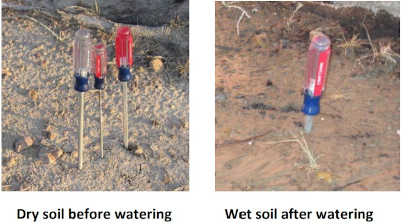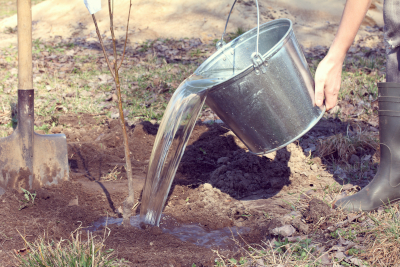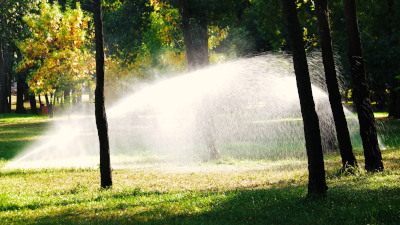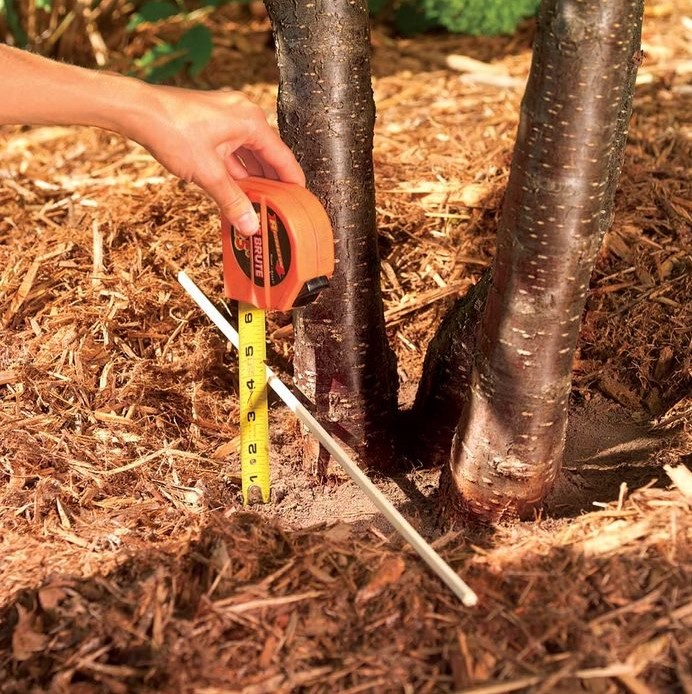Help for Thirsty Trees
Trees provide important benefits to our community and are difficult to replace. It is important to keep them healthy. Perhaps the biggest challenge facing Austin trees is lack of water. When trees don’t receive the water that they need for a long period of time, they become stressed. Stressed trees are more prone to pests or diseases, and this leads to their decline and death.
When to water
Most trees need to be watered if we have not received at least one inch of rain for one week. This varies with tree age, tree species, and the type of soil. In west Austin, the soil layer is thin and loses moisture quickly. In many parts of east Austin, the soil has more clay and might be over two feet deep. Clay soil tends to soak up water slowly, then hold it a long time. Some parts of Austin have gravelly or sandy soil that dries out quickly. The best way to know when to water is to dig into the soil and see if it’s dry. Once you get to know your soil, you will get better at predicting when your tree should be watered.
At the end of a hot summer, this tree's leaves are turning brown and falling early. Proper irrigation could help it recover.
Since most tree roots are close to the surface, you only need to check for moisture in the top 6-12 inches of soil. If you find that the soil is dry or barely damp, you should water. At first, you might want to use a shovel so you can get a good look at where the soil is moist. With practice, you can learn this by feel using a screwdriver--it can easily be pushed into moist soil, while dry soil offers more resistance. For best results, water early in the morning to reduce loss from evaporation.

With practice, you can learn to test your soil with a screwdriver so you know when it's time to water.
How to water
Some watering methods are better than others. An occasional slow soaking is better than frequent, short bursts. Overhead sprinklers are simple and affordable, but tend to waste water. A licensed irrigator can install automatic systems to accommodate trees' special needs. Soaker hoses generally do the best job at getting the water into the soil. Add a layer of mulch over the hoses for even better results.

Trees are well adapted to receive water from the surface. Even pouring from a bucket helps. It's important to pour slowly enough to allow the water to soak in around the trees root zone.

Water sprayed over the surface of a landscape will benefit trees, but some is lost to evaporation. It's best to finish watering before the day heats up.

An array of soaker hoses allows water to seep into soil slowly. Cover it with a layer of mulch to reduce evaporation from the soil surface.

Mulch works best in a layer three to four inches deep.
Where to water
Most tree roots live near the surface and spread outward up to three times the height of the tree. So, instead of watering at the base of the tree trunk, water should be spread throughout the root zone. Even if we can’t get water everywhere we want it, watering wherever possible will help the tree survive.

Most tree roots are not very deep in the soil, but they spread outward far beyond the branches.
How much water
We know to check our soil to see when to water, but how do we know when to turn off the water? It will vary based on the type of tree, the age of the tree, the soil type, and how you are applying the water. If you are using a soaker hose, let it run for 30 minutes, then check on how far the water actually moved down into the soil. You can stop watering when water has soaked down 6 inches or more.
Tree age is important. For example:
- A young tree won’t have as many roots and they won’t reach out as far as a mature one. Concentrate more water near the stem.
- A tree that grew naturally will have wider, deeper roots than a transplant from a nursery. Water a larger area around the tree.
- Newly planted trees might need to be watered twice a week or more. Check the container soil, not the surrounding lawn.
- Check soil weekly for trees that are vulnerable. Give extra care to trees for the first three years after planting. Other at-risk trees include those with pests or disease and very old ones that have begun to decline.
- Mature, established trees can usually manage without water for two to four weeks. Just be sure to water thoroughly when the soil becomes dry.
Resources:
You can get free mulch for your trees and plants from Austin Resource Recovery. Bring your own tools and containers.
You can learn about current watering restrictions and find your watering days at the Austin Water site.
This information is sponsored by the City of Austin. Learn more about trees and resources at the Tree Information Center!


